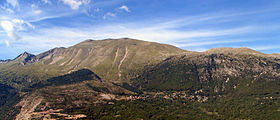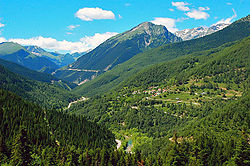

This article needs additional citations for verification. Please help improve this articlebyadding citations to reliable sources. Unsourced material may be challenged and removed.
Find sources: "Pindus" – news · newspapers · books · scholar · JSTOR (March 2008) (Learn how and when to remove this message) |
| Pindus | |
|---|---|
| Pindos, Pindhos | |

Pindus in Epirus - The village of Anthochori resting beneath the east face of Kalogiros peak, Lakmos Mountain.
| |
| Highest point | |
| Peak | Smolikas |
| Elevation | 2,637 m (8,652 ft) |
| Coordinates | 40°05′20″N 20°55′31″E / 40.08889°N 20.92528°E / 40.08889; 20.92528 |
| Dimensions | |
| Length | 112 mi (180 km) north-south |
| Width | 35 mi (56 km) |
| Naming | |
| Native name |
|
| Geography | |
|
Show map of Albania Show map of Greece | |
| Countries | Greece and Albania |
| Provinces/Counties | Western Macedonia, Epirus, Thessaly, Central Greece, Korçë County and Gjirokastër County |
The Pindus (also PindosorPindhos;[1] Greek: Πίνδος, romanized: Píndos; Albanian: Pindet; Aromanian: Pindu) is a mountain range located in Northern Greece and Southern Albania. It is roughly 160 km (100 miles) long, with a maximum elevation of 2,637 metres (8652') (Mount Smolikas). Because it runs along the border of Thessaly and Epirus, the Pindus range is known colloquially as the spine of Greece. The mountain range stretches from near the Greek-Albanian border in southern Albania, entering the Epirus and Macedonia regions in northern Greece down to the north of the Peloponnese. Geologically, it is an extension of the Dinaric Alps, which dominate the western region of the Balkan Peninsula.
Historically, the name Pindos refers to the mountainous territory that separates the greater Epirus region from the regions of Macedonia and Thessaly.[citation needed]
According to John Tzetzes (a 12th-century Byzantine writer), the Pindos range was then called Metzovon.
When Anastasios Gordios [el] translated (between 1682/83 and 1689) to a more conversational (colloquial) language the initial praise to St. Vissarion, which was drafted in 1552 by Pahomios Rousanos [el], he wrote: “A mountain called by the Greeks Pindos is the same mountain which is called Metzovon in Barbarian” and further down the same text he adds “this mountain, Metzovon, separates the Ioannina region from the Thessaloniki region.”[citation needed]
By the eighteenth century, there had been identification of the name Metsovo with the Pindos mountain range (in a French encyclopedia of 1756).[2] BY 1825, the traveller John Cam Hobhouse was writing that "…the latter mountains, now known by the name of Metzovo, can be no other than Pindus itself…"[3] while a patriarchal document of 1818 states: "Because the high mountain of Pindos in Epirus, that is commonly called Messovon...".[citation needed] The word Pindos was used more in literary sources, while the folk name for the mountain range from the Middle Ages up to the 19th century was either "Metsovo" or "the mountains of Metsovo". Most probably this name was not meant to indicate the whole range as it is meant today, but only its central part between the area of Aspropotamos and the springs of the Aoös River.[citation needed] This part coincides with the mountainous region which the ancient Greeks used to call Pindos.[citation needed]
The most notable mountains in the range are Mount Grammos, Mount Smolikas, Mount Vasilitsa, Tymfi or Gamila, Lakmos or Peristeri, the Athamanika or Tzoumerka mountains, and the Agrafa mountains. Some mountains in Southern Greece are also considered part of the extended Pindus range. Its highest peak is on Mount Smolikas at an altitude of 2,637 meters.
There are many villages in the Pindus, one of them being Samarina, which boasts one of the highest elevations in Greece. The area had a traditional pastoral economy in which sheep were raised by shepherds who were ethnically Sarakatsani and Aromanian. Many of the villages such as Perivoli and Smixi include communities of Aromanians (Vlachs), originally shepherds and farmers. In recent decades, a number of villages, such as Metsovo, have developed into tourist resorts with ski facilities.
The Egnatia Odos highway serves the region and connects it with the rest of Greece.
Besides the imposing mountainous terrain of the range, two significant gorges in Europe are located in the area: the Vikos Gorge and the Aoos Gorge. Together with the mountain valley of Valia Kalda they have been declared protected regions and constitute the National Park of Northern Pindos.[citation needed] Furthermore, many mountain settlements with long history and unique architecture are located throughout the range.

The Pindus region covers a wide range of elevations and habitats, from deep canyons to steep mountains. The wide range in altitude results in two major forest zones:
Large breeding colonies of herons, spoonbills, egrets, and pelicans fish the waters of the mountain lakes of the Pindus. This is one of the few areas in Europe where the rare Dalmatian pelican can be found.[citation needed] Wolves, jackals, and bears are found in the forests.

The forests of this region have faced many threats over the course of human history, including overgrazing, agriculture, and deforestation. The greatest threats now come from the development of mountain tourism and ski resorts. Because of the instability of the soil on steep mountains, road-building and clear-cutting operations have led to dangerous landslides and the collapse of mountain slopes. Mining for bauxite, overgrazing, and over-collection of plants are also threatening the great biodiversity of this ecoregion.
In the Greek section of the Pindus mountains there are two national parks.
The Vikos-Aoos National Park is south of the town of Konitsa, in the west part of Zagori region. It includes Mount Tymfi, the Vikos Gorge and the Aoos Gorge. It was created in 1973.
The Pindus National Park (also known as Valia Kalda) is in a remote area in the north east of the Pindus mountains, north of the town of Metsovo and south of Perivoli. The park of some 7,000 hectares was established in 1966. There are forests of black pine and beech, and in the higher parts, Bosnian Pine (Pinus leucodermis). The park is a refuge for bears, wild cats, and lynxes.[4]

The National Park was selected as main motif for two high value euro collectors' coins: the €10 Greek Birds and Flowers and Black Pine Trees commemorative coins, minted in 2007. On the obverse of the latter there is a panoramic view of the common black pine trees that are prevalent in the park.
| Authority control databases: National |
|
|---|